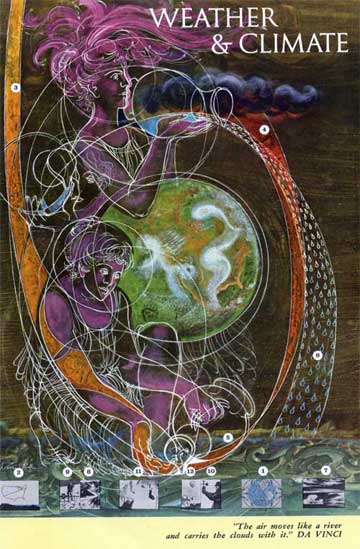 Fifty-year-old science booklet
waxes eloquent
Fifty-year-old science booklet
waxes eloquent
By Ned Rozell
February 23, 2008
Saturday
In 1958, Paul Newman married Joanne Woodward, the U.S. launched
its first satellite, Ted Williams signed with the Red Sox for
$135,000, Alaska became the 49th state, and Frank Zappa graduated
from a California high school.
 One of the six posters
produced by a New York company for the National Academy of Sciences
in 1958 to mark the last International Polar Year, also known
as the International Geophysical Year. Courtesy The National
Academies.
One of the six posters
produced by a New York company for the National Academy of Sciences
in 1958 to mark the last International Polar Year, also known
as the International Geophysical Year. Courtesy The National
Academies.
|
Fifty years ago also marked
the last time scientists got together all over the world for
what they called an International Polar Year. As part of that
effort, a renaissance man named Hugh Odishaw, who studied English
literature, math, and electrical engineering, helped put together
a booklet that accompanied six National Academy of Sciences posters
designed to excite people about science. He did this task with
enthusiasm for the International Polar Year, an event he thought
was "the single most significant peaceful activity of mankind
since the Renaissance and the Copernican Revolution."
I saw the booklet at a science
conference and started browsing it. As someone on the lookout
for science stuff that's simplified but not too dumbed-down,
I appreciated Odishaw and his partners' effort 50 years ago.
Here are a few excerpts from the hard-to-find "Planet Earth;
the Mystery with 100,000 Clues."
- "As early as 1673, man
developed the theory that as the earth spins, centrifugal force
causes the equator to bulge and the poles to flatten. . . Because
the flattened poles are about 13 miles closer to the center of
the earth, the pull of gravity is stronger there. In fact, a
200-pound man (at the equator) would weigh about 201 pounds at
the poles."
- Earth has daily tides, something
like those in the oceans but much less noticeable. Still, the
island of Hawaii, for example, rises and falls several inches
a day."
- "The freezing waters
of the Antarctic are by far the richest in sea life, while many
of our tropical waters are relatively sparse."
- "The South Pole receives
more sunlight than any place on Earth during December, its midsummer.
But almost all of it is reflected back into the atmosphere. This
is why there is very little melting."
- "The word 'moving' is
the key to an understanding of weather. No property of the atmosphere
is more important than its motion. Winds distribute heat from
the tropics to other areas, carry moisture from the oceans over
the continents where it falls as rain, push polluted air out
of the cities and bring in clean air to replace it. If our atmosphere
stopped moving, the tropics would become intolerably hot and
the rest of the planet unbearably cold. The rainless continents
would become dust; the cities would suffocate in their own fumes."
- "All the world's winds
would stop were their energy not continually renewed by a most
powerful generator-the sun. By heating the air and evaporating
the water, it keeps our atmosphere moving."
- "As this furious (hydrogen
reaction) process goes on, the sun's loss of weight is estimated
at over four million tons a second. Yet it may maintain its temperature
for another 35 billion years without noticeable loss."
- "The earth is a small
target for the sun's radiations. Only a half a billionth part
of the total solar radiation strikes the earth. Yet this is enough
to keep our planet comfortably above the absolute zero temperatures
in space, to power the circulation of our atmosphere and oceans,
and to sustain life."
- "Our industrial civilization
has been pouring carbon dioxide into the atmosphere at a great
rate. By the year 2000 we will have added about 70 percent more
carbon dioxide to the atmosphere. If it remained, it would have
a very marked warming effect on the earth's climate, but most
of it will probably be absorbed by the oceans. Conceivably, however,
it could cause significant melting of the great icecaps and raise
sea levels in time."
This column is provided as a public service by the Geophysical
Institute, University of Alaska Fairbanks, in cooperation with
the UAF research community.
Ned Rozell [nrozell@gi.alaska.edu]
is a science writer at the institute.
E-mail your news &
photos to editor@sitnews.us
Publish A Letter in SitNews Read Letters/Opinions
Contact the Editor
SitNews
©2008
Stories In The News
Ketchikan, Alaska
|

